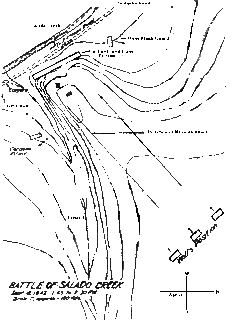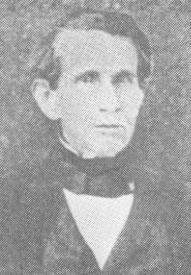
The Texas Revolution was a rebellion of colonists from the United States and Tejanos in putting up armed resistance to the centralist government of Mexico. While the uprising was part of a larger one, the Mexican Federalist War, that included other provinces opposed to the regime of President Antonio López de Santa Anna, the Mexican government believed the United States had instigated the Texas insurrection with the goal of annexation. The Mexican Congress passed the Tornel Decree, declaring that any foreigners fighting against Mexican troops "will be deemed pirates and dealt with as such, being citizens of no nation presently at war with the Republic and fighting under no recognized flag". Only the province of Texas succeeded in breaking with Mexico, establishing the Republic of Texas, and eventually being annexed by the United States.

Courtland is a town in Lawrence County, Alabama, United States, and is included in the Decatur Metropolitan Area, as well as the Huntsville-Decatur Combined Statistical Area. The population was 609 at the 2010 census, down from 769 in 2000.

Goliad is a city in Goliad County, Texas, United States. It is known for the 1836 Goliad massacre during the Texas Revolution. It had a population of 1,908 at the 2010 census. Founded on the San Antonio River, it is the county seat of Goliad County. It is part of the Victoria, Texas, Metropolitan Statistical Area.

The Goliad massacre was an event of the Texas Revolution that occurred on March 27, 1836, following the Battle of Coleto; 425–445 prisoners of war from the Texian Army of the Republic of Texas were executed by the Mexican Army in the town of Goliad, Texas. Among those killed was their commander Colonel James Fannin. The killing was carried out under orders from General and President of Mexico Antonio Lopez de Santa Anna. Despite the appeals for clemency by General José de Urrea, the massacre was reluctantly carried out by Lt. Colonel José Nicolás de la Portilla.

The Goliad Campaign was the 1836 Mexican offensive to retake the Texas Gulf Coast during the Texas Revolution. Mexican troops under the command of General José de Urrea defeated rebellious immigrants to the Mexican province of Texas, known as Texians, in a series of clashes in February and March.

The Battle of Coleto, also known as the Battle of Coleto Creek, the Battle of the Prairie, and the Batalla del Encinal del Perdido, was fought on March 19–20, 1836, during the Goliad campaign of the Texas Revolution. In February, General José de Urrea led a branch of the Mexican army up the Gulf Coast of Mexican Texas toward Goliad, where a large contingent of soldiers from the Texian Army was garrisoned under Colonel James W. Fannin. Simultaneously, Mexican president Antonio Lopez de Santa Anna led a larger force into the Texian interior, where on March 6 his troops won the Battle of the Alamo. After learning of the Alamo's defeat, Texian general Sam Houston ordered Fannin to retreat from Goliad and join the rest of the army in Victoria.

James Walker Fannin Jr. was a 19th-century slave-trader and American military figure in the Texas Army and leader during the Texas Revolution of 1835–36. After being outnumbered and surrendering to Mexican forces at the Battle of Coleto Creek, Colonel Fannin and nearly all his 344 men were executed soon afterward at Goliad, Texas, under Santa Anna's orders for all rebels to be executed.

The Battle of Goliad was the second skirmish of the Texas Revolution. In the early-morning hours of October 9, 1835, Texas settlers attacked the Mexican Army soldiers garrisoned at Presidio La Bahía, a fort near the Mexican Texas settlement of Goliad. La Bahía lay halfway between the only other large garrison of Mexican soldiers and the then-important Texas port of Copano.

The Battle of Refugio was fought from March 12–15, 1836, near Refugio, Texas. Mexican General José Urrea and 1,500 Centralista soldiers fought against Amon B. King and his 28 American volunteers and Lieutenant Colonel William Ward and his approximately 120 Americans. The battle, a part of the Goliad Campaign of the Texas Revolution, resulted in a Mexican victory and splintered Texan resistance.

The Battle of San Patricio was fought on February 27, 1836, between Texian rebels and the Mexican army, during the Texas Revolution. The battle occurred as a result of the outgrowth of the Texian Matamoros Expedition. The battle marked the start of the Goliad Campaign, the Mexican offensive to retake the Texas Gulf Coast. It took place in and around San Patricio.

The Battle of Agua Dulce Creek was a skirmish during the Texas Revolution between Mexican troops and rebellious colonists of the Mexican province of Texas, known as Texians. As part of the Goliad Campaign to retake the Texas Gulf Coast, Mexican troops ambushed a group of Texians on March 2, 1836. The skirmish began approximately 26 miles (42 km) south of San Patricio, in territory belonging to the Mexican state of Tamaulipas.

The Texian Army, also known as the Revolutionary Army and Army of the People, was the land warfare branch of the Texian armed forces during the Texas Revolution. It spontaneously formed from the Texian Militia in October 1835 following the Battle of Gonzales. Along with the Texian Navy, it helped the Republic of Texas win independence from the Centralist Republic of Mexico on May 14, 1836 at the Treaties of Velasco. Although the Texas Army was officially established by the Consultation of the Republic of Texas on November 13, 1835, it did not replace the Texian Army until after the Battle of San Jacinto.

The Presidio Nuestra Señora de Loreto de la Bahía, known more commonly as Presidio La Bahía, or simply La Bahía is a fort constructed by the Spanish Army that became the nucleus of the modern-day city of Goliad, Texas, United States. The current location dates to 1747.

The Battle of Lipantitlán, also known as the Battle of Nueces Crossing, was fought along the Nueces River on November 4, 1835 between the Mexican Army and Texian insurgents, as part of the Texas Revolution. After the Texian victory at the Battle of Goliad, only two Mexican garrisons remained in Texas, Fort Lipantitlán near San Patricio and the Alamo Mission at San Antonio de Béxar. Fearing that Lipantitlán could be used as a base for the Mexican army to retake Goliad and angry that two of his men were imprisoned there, Texian commander Philip Dimmitt ordered his adjutant, Captain Ira Westover, to capture the fort.
Philip Dimmitt (1801–1841) was an officer in the Texian Army during the Texas Revolution. Born in Kentucky, Dimmitt moved to Texas in 1823 and soon operated a series of trading posts. After learning that Mexican General Martín Perfecto de Cos was en route to Texas in the year 1835 (??) to quell the unrest, Dimmitt proposed that the general be kidnapped on his arrival at Copano. The plan was shelved when fighting broke out at Gonzales, but by early October, 1835, it had been resuscitated by a group of volunteers at Matamoros. Not knowing that Cos had already departed for San Antonio de Bexar, this group decided to corner Cos at Presidio La Bahia in Goliad. Dimmitt joined them en route, and participated in the battle of Goliad.

The Battle of Salado Creek was a decisive engagement in 1842 which repulsed the final Mexican invasion of the Republic of Texas. Colonel Mathew Caldwell of the Texas Rangers led just over 200 militia against an army of 1,600 Mexican Army soldiers and Cherokee warriors, and defeated them outside of San Antonio de Bexar along Salado Creek. As a result of this action, French-Mexican commander General Adrián Woll retreated south and back into Mexico.
Plácido Benavides (1810–1837) was an early Mexican-born settler in De Leon's Colony, Victoria County, Texas. Benavides earned himself the sobriquet of the Paul Revere of Texas for his 1836 journey from San Patricio to Goliad to Victoria, warning residents of the approaching Mexican army. He was twice elected alcalde of Victoria, Texas. He married into the powerful De León family, and with his wife Agustina became the father of three daughters. Benavides fought against the dictatorship of Antonio López de Santa Anna, but did not feel Texas should be separated from Mexico.

Jack Shackelford was an American doctor, politician and soldier. He raised and led a unit in Courtland, Alabama called the Red Rovers or the Alabama Red Rovers to fight in the Texas Revolution. He was one of the few survivors of the Goliad massacre.
Isaac D. Hamilton (1804-1859) was a Texas Revolutionary soldier and survivor of the Goliad Massacre. A native of Alabama, Hamilton joined Dr. Jack Shackelford's Red Rovers in 1835 and fought in the Battle of Coleto where he was badly wounded. Hamilton escaped the massacre of 425 men on March 27, 1836, along with three other members of the Red Rovers, including Dillard Cooper. Hamilton's wounds made travel painful and slow and, at his own insistence, the other three left him behind. Hamilton was recaptured and was in transit to be executed when two Mexican women helped him make his escape. He linked back up with Texian forces and eventually made his way back to Alabama.
The Red Rovers, commonly referred to as the Alabama Red Rovers, was a filibuster force organized in Courtland, Alabama to support the Texas Revolution. Raised by doctor and planter Jack Shackelford in November 1835, the unit took its name from the red jeans of their uniforms and was outfitted with equipment from Alabama state arsenal. Consisting of some 70 men, nearly half the men in Courtland, the unit remained encamped until December 12 before setting out for Texas by way of New Orleans. After arriving at Lavaca Bay on January 19, 1836 and being accepted into Texas service on February 3, the Red Rovers were put under command of Colonel James W. Fannin. They fought in the Battle of Coleto on March 19–20, performing well, but the Texians were overrun and ultimately forced to surrender











